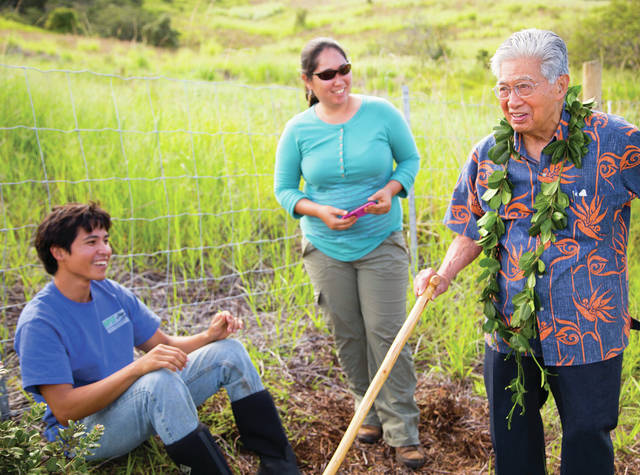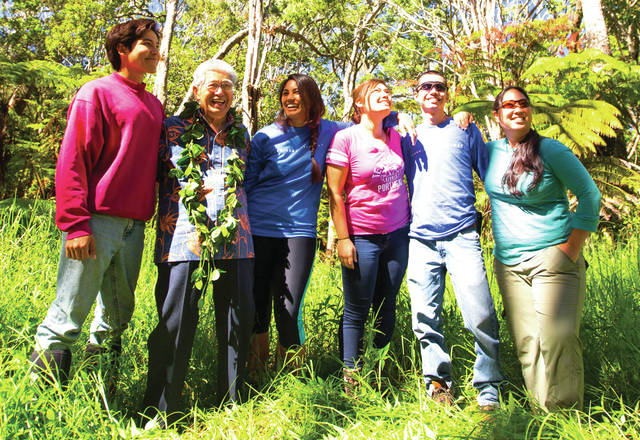Protecting and promoting Hawaii’s natural and cultural resources: Akaka Foundation launches new efforts
WAIMEA — Retired U.S. Sen. Daniel K. Akaka worked tirelessly to protect the state’s natural and cultural resources.
He had Hawaii’s future generations in mind when he led passage of the 1992 Tropical Forest Recovery Act, which established the Hawaii Experimental Tropical Forest on Hawaii Island in 2007.
As a living legacy to Akaka’s life and work, The Akaka Foundation for Tropical Forests (AFTF) was formed in late 2015. Founded by a group of like-minded, hardworking and environmentally aware community leaders, scholars and scientists, their mission is to enhance and promote forest stewardship in the islands.
A nonprofit organization run by volunteers, AFTF embraces biocultural restoration and conservation strategies through the integration of traditional and western knowledge, and strategic cooperation among private and public organizations. Its vision is “vibrant forest communities, alive with the voices of Hawaii from one generation to the next.”
As many people know, the Hawaiian archipelago is the most remote island chain in the world. But what is not widely known is that, over the course of five million years of geological history, all forms of life have traversed to the islands by wave, wind or wing. The resulting colonizations have made Hawaii home to more than 10,000 native species, most of which are endemic and found nowhere else on earth.
Of specific interest to AFTF are the island’s 175-plus native tree species which make up 48 distinct types of native forest and woodlands. These forests provide critical habitat for native plants and animals, and also generate clean water, air, and healthy soils; control erosion; protect coral reefs; and mitigate climate change.
Sadly, Hawaii has another world distinction — extinction capital of the world. The Aloha State is home to the largest number of federally listed threatened or endangered plant and animal species in the U.S., including 343 listed plant and 294 listed animal species.
Over the last two centuries, the threats to and loss of native ecosystems and Hawaii’s native culture have greatly accelerated. AFTF President Robert “Bob” Masuda of Waimea says the situation is dire enough that, “Within the lifetimes of our children, Hawaii may lose its remaining native forests.”
The impacts of such a loss would be devastating on native species, ecosystem services and the traditional cultural practices that the native forests support.
There is hope to protect what remains, Masuda said, but time is running out.
And that’s where AFTF comes in.
According to its first annual report, 2016 was a year of planting seeds for AFTF both literally and philosophically. The foundation has formed partnerships with numerous organizations to maximize returns, and draw from multiple knowledge systems for effective resource management.
The foundation continued its support of the Ulu Lehulehu, or Million Ohia Initiative, which promotes the protection, planting and restoration of ohia lehua. An ecological keystone of Hawaii’s native forests and watersheds, ohia lehua covers more than one million acres statewide. It provides habitat for countless native species of plants, birds and insects, and is a cultural keystone for native Hawaiian people in support of their beliefs, traditional lifeways and practices.
Through the initiative, AFTF is working to bring ohia back to the built environment and inhabited landscapes, as well as mitigate the impact of invasive species and diseases such as Rapid Ohia Death. Ulu Lehulehu has reached more than 1,700 Hawaii Island students through classroom visits, and has raised and distributed 1,200 ohia seedlings to school and community groups. It has also been shared with tens of thousands of citizens through presentations and social media.
A second current Akaka Foundation endeavor is the Cultural Keystones Initiative. It promotes the protection, planting and restoration of plant species that are of high cultural and ecological value to Hawaii. These include kamani, kou, milo, kauila, iliahi, alahee and lama.
Lastly, the AFTF’s Koa Initiative seeks to expand forest cover through the planting of Acacia koa, a fast growing tree species found only in Hawaii and the state’s premier timber species. Koa is suited for restoration of Hawaii’s degraded pasture lands because it has a high capacity to enrich soils, create critical habitat for endangered forest birds, sequester carbon and provide shade for other native plants.
The Koa Initiative supports diverse projects focused on returning koa forest cover in Hawaii including tree improvement, partnership-driven watershed restoration, smaller stewardship projects, regeneration, silviculture, sustainable harvesting and conservation genetics.
AFTF Vice President Michael Chun of Waimea says that as an organization AFTF in unique because in addition to resourcing scientists who know flora and fauna and what is needed for a healthy forest, it also respects, incorporates and integrates a culture view of forest well-being.
“It’s not just looking at things with the eyes of a scientist. It’s also looking at things with the eye of the Hawaiian culture,” he said. “We are looking at caring for the forest using modern-day science as well as native Hawaiian practices.”
Throughout the remainder of 2017, AFTF will continue its biocultural outreach through support of the annual Puu Waawaa Biocultural Blitz, and outreach at local schools.
AFTF has expanded these efforts to include the Keikis of da Aina Hunting Tournament, and by hosting two Kapili Oihana interns through a pilot program at a local public charter school. It also is a partner in the STEW-Map Hawaii Project, which will create a publicly available map of stewardship groups in North Kona and South Kohala.
As chairman emeritus of the AFTF, Akaka couldn’t be happier about the organization’s efforts to educate Hawaii’s youth on the role they play in revitalizing Hawaii’s forests.
“Hawaii is the only state in the union that is designated to have two tropical forests and a wetland,” he said.
There is also the dry land forest preserve near Waikoloa.
“These are the kinds of areas we’re working on and it’s primarily to sustain the forests,” Akaka continued, but under the status quo not many people in Hawaii know about it. “We need education programs so that our people, and especially our children, will know what we have in our front yard,” he concluded.
A summation by AFTF Treasurer Paul Nakayama of Waimea is even more succinct.
“What I like best about the Akaka Foundation are the programs that impart knowledge to the children, inspiring them to care for the forests because they are the future stewards,” he said. “They have to take on stewardship or protection of the forests is not going to happen no matter what we do. It won’t happen without their participation.”
AFTF will help steer the future of Hawaii to a more sustainable, bountiful and culturally valued home for its people, and can provide a great example for the rest of the world. Contributions may be made to the nonprofit organization.
For more information, visit www.akakaforest.org.




